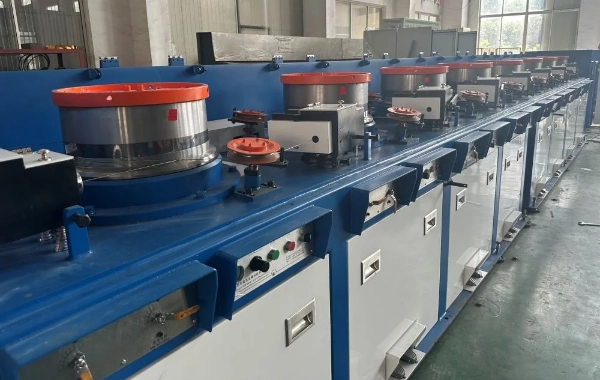In the modern welding industry, the quality and performance of welding wire directly influence the efficiency, stability, and safety of welding operations. Among various manufacturing processes, the welding wire CO₂ drawing machine plays a critical role in producing high-quality CO₂ gas-shielded welding wire. By integrating advanced mechanical engineering with precise control systems, this machine ensures consistent wire dimensions, surface quality, and mechanical properties, meeting the stringent demands of industrial welding applications. In this blog post, as a high performance automatic wire drawing machine factory, Yifam will share the importance of welding wire co2 drawing machine in precision manufacturing.
1. Understanding the Welding Wire CO₂ Drawing Process
The CO₂ welding process uses a continuous consumable wire electrode as filler material, typically shielded by a CO₂ gas flow to prevent oxidation and contamination. Producing this wire requires a sophisticated drawing process in which raw steel rods are reduced in diameter through a series of dies until they reach the desired specification.
The welding wire CO₂ drawing machine is designed specifically for this application. It progressively draws steel wire rods, ensuring accurate diameter control and a clean, defect-free surface. The drawing operation also improves the tensile strength and ductility of the wire, making it suitable for high-performance welding tasks.
2. Key Components of Welding Wire CO₂ Drawing Machine
A modern CO₂ welding wire drawing machine is an assembly of high-precision components, each contributing to stable and efficient operation.
2.1 Pay-Off System
The pay-off system feeds steel rods into the drawing machine. It is designed to handle coil or spool formats without tangling, ensuring a smooth start to the process.
2.2 Drawing Blocks and Dies
Multiple drawing blocks work in sequence, pulling the wire through tungsten carbide or polycrystalline diamond dies. Each die reduces the wire diameter by a controlled percentage to avoid excessive strain.
2.3 Annealing Unit
Intermittent or continuous annealing may be integrated to relieve internal stresses, enhance ductility, and improve wire feed performance during welding.
2.4 Surface Treatment System
Before or after drawing, the wire undergoes surface cleaning—removing oxides, scale, and contaminants—to ensure optimal electrical conductivity and uniform coating adhesion if required.
2.5 Take-Up System
The finished welding wire is wound onto spools or drums in a tension-controlled manner, maintaining consistent coil density for trouble-free unwinding during welding.

3. Advantages of Using CO₂ Welding Wire Drawing Machine
The adoption of a specialized welding wire CO₂ drawing machine offers several significant advantages for manufacturers.
3.1 Dimensional Accuracy
The machine maintains precise wire diameters, typically within micrometer tolerances, essential for stable welding arcs and uniform bead formation.
3.2 Enhanced Surface Quality
Smooth, defect-free surfaces minimize feeding resistance and reduce the risk of arc instability or wire burn-back.
3.3 Mechanical Strength Optimization
Controlled drawing strain combined with annealing improves tensile strength without sacrificing flexibility, ensuring excellent feeding performance in automatic welding systems.
3.4 High Productivity
Multi-block configurations allow continuous high-speed production while maintaining consistent quality.
4. Process Flow in CO₂ Welding Wire Production
Producing welding wire with a CO₂ drawing machine generally follows this sequence:
-
Wire Rod Preparation – Uncoiling, straightening, and cleaning.
-
Initial Drawing – Large diameter reduction through first-stage dies.
-
Intermediate Annealing – Optional heat treatment to restore ductility.
-
Final Drawing – Fine reduction to achieve the target wire size (e.g., 0.8 mm, 1.0 mm, 1.2 mm).
-
Surface Treatment – Copper coating or other finishes to enhance conductivity and corrosion resistance.
-
Spooling – Winding the finished wire for storage and transport.
5. Applications of CO₂ Welding Wire Produced by Drawing Machines
The wire manufactured using a welding wire CO₂ drawing machine is primarily intended for gas metal arc welding (GMAW) with CO₂ shielding gas, widely used in:
-
Automotive Manufacturing – Body assembly and structural welding.
-
Shipbuilding – Hull fabrication and reinforcement welding.
-
Construction – Steel frame welding in buildings and bridges.
-
Pipeline Welding – High-strength, corrosion-resistant joints.
-
Heavy Equipment Fabrication – Excavators, cranes, and industrial machinery.
6. Quality Control in CO₂ Welding Wire Drawing
Maintaining consistent quality requires rigorous monitoring at every production stage.
6.1 Diameter Measurement
Laser micrometers provide real-time diameter control, ensuring tolerances are met.
6.2 Surface Inspection
Automated visual inspection systems detect scratches, pits, or coating defects.
6.3 Mechanical Testing
Samples are tested for tensile strength, elongation, and bend resistance to verify mechanical performance.
6.4 Weldability Testing
Trial welding ensures stable arc ignition, smooth feeding, and minimal spatter.
7. Energy Efficiency and Environmental Considerations
Modern welding wire CO₂ drawing machines incorporate energy-saving technologies, such as variable frequency drives (VFDs) to optimize motor performance and heat recovery systems in annealing units. Additionally, closed-loop lubrication and filtration systems reduce oil consumption and environmental impact.
Manufacturers are increasingly focusing on eco-friendly production, including the use of low-toxicity coatings and recyclable packaging for finished wire products.
8. Choosing the Right Welding Wire CO₂ Drawing Machine
Selecting the right machine involves evaluating several factors:
-
Production Capacity – Number of drawing blocks, maximum line speed.
-
Wire Size Range – Minimum and maximum diameters achievable.
-
Automation Level – Integration with handling robots and monitoring systems.
-
Material Compatibility – Carbon steel, low-alloy steel, or stainless steel.
-
Maintenance Requirements – Accessibility of dies, ease of lubrication, and replacement parts availability.
Conclusion
The welding wire CO₂ drawing machine is a cornerstone of modern welding consumable production. By combining mechanical precision, advanced materials, and process control, it ensures the delivery of welding wires that meet the highest industry standards. As manufacturing demands evolve, these machines will continue to advance, offering higher productivity, better quality, and improved sustainability for the global welding industry.
www.yifam.com
Yifam
